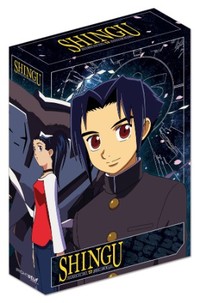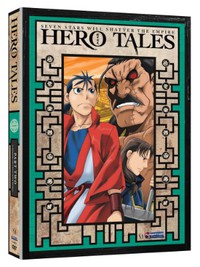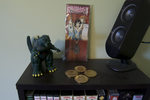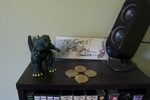Shelf Life
Kuri Runnings
by Erin Finnegan,

FLCL Complete Collection BD
Rental Shelf
Shingu: Secret of the Stellar Wars Thinpak Collection DVD
Hero Tales part 2 DVD
Perishable
Nothing this week
I was reminded of the '90s and MiBs watching Shingu this week, which captured the conspiratorial UFO spirit of the time period (even though it came out in 2000).
 Shingu is a nice, quiet little sci-fi show with a leisurely pace – it probably won't set your world on fire. The first three quarters of the show ask the not-so-dramatic question: what if aliens came to Earth, nobody panicked, and everything turned out OK? It's the year 2070, and governments around the world are forced to publicly admit that yes, aliens exist, and yes, they've been covering it up for years. Life on Earth continues normally. That may be alright for Earth, but it just doesn't make for a dramatic or compelling television show.
Shingu is a nice, quiet little sci-fi show with a leisurely pace – it probably won't set your world on fire. The first three quarters of the show ask the not-so-dramatic question: what if aliens came to Earth, nobody panicked, and everything turned out OK? It's the year 2070, and governments around the world are forced to publicly admit that yes, aliens exist, and yes, they've been covering it up for years. Life on Earth continues normally. That may be alright for Earth, but it just doesn't make for a dramatic or compelling television show.Our humble protagonist Hajime attends junior high in Tenmo, a town he moved to when he was 10. One day a mysterious transfer student, Muryou, arrives, wearing a school uniform that hasn't been popular for generations. Hajime sees something he shouldn't and he suddenly finds himself in the midst of a conspiracy perpetrated by certain Tenmo residents. At the center of this plot is the Shingu, a giant, god-like, robot-thing that sometimes appears to defend Tenmo from alien spacecraft.
Apart from Hajime, Muryou, and their friends, the adults of Tenmo get a surprising amount of screen time. Jiltosh is a local eccentric collector of Hawaiian shirts who also happens to be an alien dignitary who has learned the local customs. He subjects new alien visitors to "welcome parties" and generally gets every adult character in the show drunk every third episode or so. Shingu would be more aptly titled “Secret of the Nomikai Wars”.
This show should be awesome and exciting, but it has absolutely no interest in being that kind of show. Instead it plods lackadaisically forward through Hajime's final exams, summer vacation, and the school sports and cultural festivals. Don't get me wrong, Shingu does a good job of making Hajime's slightly-futuristic school feel unique, and even the festival episodes don't feel tired compared to newer series. The same is true for many of the supporting characters – even though student counsel vice president Nayuta is a strong-willed hot-cold type who wants to do everything by herself (and thus has to inevitably learn that true strength comes from her friends working together), she feels like a real person and not just an archetype.
It makes me feel self-consciously bloodthirsty to say that I was disappointed the series has a low body count. I don't expect all alien invasion stories to be as testosterone-driven as Independence Day, but it seriously tried my patience when attacking alien soldiers were talked down by school teachers over tea…more than once.
The dub is adequate, but unmemorable. Billy Regan sounds too old to be believable as Hajime. He has the character's attitude right, but he sounds vaguely miscast. A few incidental festival songs the characters sing have been given new lyrics in the dub, but in the subtitles, the lyrics are directly given as “Wasshoi! Wasshoi!” Student counsel president Hachiyou sounded so odd singing in English that I continually switched back to the Japanese track.
As I mentioned above, the show came out in 2000, but the cel-based animation (or perhaps early digital paint?) made me think this was much older. The thinpak collection from Right Stuf re-packages a series they've been releasing since 2005. I'd never watched it before because the trailers looked generic and forgettable. The box comes with a color booklet that includes some cute 4-koma comics, an interview with the director, production commentary, and extensive cultural notes. This is absolutely necessary, since Shingu is one of the most "Japanese" shows I've ever seen. I would have never picked up on the significance of all the jizo-like statues, gohei streamers, and autumn moon viewing if I wasn't obsessed with Japanese culture already.[TOP]
This week I also happened to watch the opposite of the laid-back Shingu, an energetic alien invasion show that I totally loved with loads of sexual innuendo, rock and roll music, and appealing character design.
 Back in the day (2004), I shelled out big bucks to get the FLCL art box.¹ Spoiler (for this review), but FLCL is one of my top favorite anime titles of all time.
Back in the day (2004), I shelled out big bucks to get the FLCL art box.¹ Spoiler (for this review), but FLCL is one of my top favorite anime titles of all time.Somehow, despite the number of times I've watched FLCL repeated on Cartoon Network, I never noticed that 13-year-old Naota was about to tell his crush (and his brother's girlfriend) Mamimi that his brother has found a new (blond) girlfriend in America just before Haruko runs Naota over with her Vespa in episode one. I guess in 2003 I was a newbie anime fan; FLCL seemed impenetrable and confusing back then. After eight years of absorbing Japanese culture, the three-wheeled truck, the winning popsicle stick, the gunpla game, and the green-jacket red-jacket Lupin debate all made perfect sense when I re-watched the series.
Even thought it's only six episodes long (maybe in part because it's only six episodes long), FLCL is infinitely re-watchable. Every frame is packed with extra animation that you might miss on the first viewing. Because FLCL was an OVA, it wasn't held to the rigorous time and budget constraints of TV anime (constraints that I have experienced first hand working in television animation). More than regular TV, but less high-end than a feature film, FLCL hits a sweet spot; it is a short, satisfying, high budget show with a coming of age story drawn, animated and told with a distinctly experimental style.
Guitars, baseball bats and guns are used interchangeably (and unrealistically) as phallic objects to represent Naota's sexual frustration. Despite radical visual shifts, everything seems to fit organically into the story. Naota's brother was a baseball star, so it makes perfect sense in this sci-fi show when Naota must overcome his fear of swinging a baseball bat to knock a plummeting satellite out of Earth's orbit.
This is the most delightful series about sexual frustration that I've ever seen. Naota's clear discomfort with puberty is made manifest by the way he is constantly deflecting double entendres from other characters. Mamimi will fool around with him, but won't go "all the way" because that would count as cheating on his brother. Anyway, Naota has a crush on the interstellar calamity-causing Haruko, and infuriatingly she is both in love with someone else AND fooling around with Naota's father. Truly, poor Naota is caught in the worst love triangle in all of anime.
Haruko is one of my favorite anime characters ever. I love that her character design is very different from your average hyper-cute anime girl. She is drawn with realistic(ish) proportions (she has hips, anyway), and her breasts squish believably against Naota. Maybe most importantly, Haruko has a multi-faceted personality, with complex motivations that she tries to obscure with her frenetic antics. The director reveals in the commentary tracks that Haruko's design is slightly ripped off from Moyoco Anno's style (think Happy Mania).
I'm sure plenty has been written elsewhere about FLCL's soundtrack, which is basically a non-diegetic Pillows album.¹ It's a must-own soundtrack to a must-own show. Furthermore, the dub is one of the all-time greatest dubs. Kari Wahlgren hits just the right weird tone as Haruko. The jokes are adapted very well; for example, a reference to an out-of-style Japanese soft drink is replaced with a gag about Crystal Pepsi.
On the commentary, director Kazuya Tsurumaki chats a bit with the translator, Shizuki Yamashita, about the in-jokes and cultural references. It's a rare commentary track that's informative, done in Japanese, and aimed at an American audience. Refreshingly, they don't talk continuously when they have nothing to say, leaving you to enjoy FLCL raw for long stretches of time.[TOP]
Sadly, not every show can be a classic like FLCL. Some TV series are just lazy Sunday afternoon one-time viewing, like Hero Tales.
 Bamboo reviewed Part One of Hero Tales while I was out last week. I watched Part One first and I totally agree with Bamboo's take on it. I'll add that the first two episodes look painfully generic and somewhat low budget (two point shading instead of three? Geez!) which made me worry this show would be a chore to slog through.
Bamboo reviewed Part One of Hero Tales while I was out last week. I watched Part One first and I totally agree with Bamboo's take on it. I'll add that the first two episodes look painfully generic and somewhat low budget (two point shading instead of three? Geez!) which made me worry this show would be a chore to slog through.Fortunately, well before Part Two, things start to look up. I was drawn into the rambling wuxia tale of Taito and his Divine Warrior friends as they face off against Keiro, an evil (or evil-ish) general aiming for the throne. Is the fate of the characters tied to the stars they represent, or are they free to make their own destiny? It's all very Back to the Future III.
The series gets bonus points in my book for having Taito experience a deep and realistic depression at the beginning of Part Two. He sleeps for days, loses his appetite, and he even tries to scratch off his divine star mark in anger. Taito has plenty of reasons to be upset; he thinks his best friend died to save him, he curses his heavy fate, etc. Taito's friends try to snap him out of his depression in thoughtful ways.
After seeing both Hero Tales and Fushigi Yugi, I'm assuming that the legend of the Divine Warriors (or the Celestial Warriors) is some standard Chinese folktale, but I'm having trouble finding more information about it (in English, anyway). I don't think it coincidental that a lot of the extras in this show look like throw-away characters from The Twelve Kingdoms, drawn more simplistically. Also, like Twelve Kingdoms (of which I am fond), at the center of Hero Tales is the concept of the divine right of kings (you don't vote for kings!). When an emperor loses the mandate of heaven, earthquakes and famine cause strife for the people until such a time as a heaven-approved ruler is found and once again takes the throne. Hero Tales seems to put forward that you can make your own fate, but it disappointingly (and suddenly) backs off of that angle at the last moment (what the heck?!).
Although the characters all have at least two sides to their personalities, the character design is incredibly poor. Taito has the exact same bangs as the archer Hosei, making them sometimes look weirdly like identical twins (ironically there are actual long lost family members involved, but I won't spoil it). At least some thought has gone into Taito's coat, which looks vaguely like an oendan outfit. But if you're into anime for the "art style," Hero Tales is going to be a huge disappointment.
The dub is OK, (I especially like the manly Jonathan Brooks as Koyo, the ship's captain), but the translation goes off the rails at times. Although the subtitles seem reasonable, some of the courtly speech in the dub starts to get slap happy with lines like "Whither the real sword?"
This would be a fine show for a syndicated Sunday afternoon timeslot (do those still exist?) and I think 10-year-old boys (and me) would enjoy watching it as such, if it weren't for the buckets of blood in this series (especially near the end). The high number of arrows to the chest would never pass muster at any network's S&P department. The final episode in particular is suddenly much better animated (complete with three-point shading), but it could never, ever be aired before midnight in America. That's too bad, really, because I think kids could really get into this show (important note: I am not a parent). Even if they couldn't follow the political plot, the show is careful to include at least one fight scene per episode.[TOP]
¹ Between 2000-2003 I watched Evangelion, Daicon IV (on a VHS tape), Oruchuban Ebichu, and FLCL and declared myself a Gainax fan for life.
²Just once I was lucky enough to see the pillows play The Knitting Factory in New York. Because I re-watched FLCL, I've ended up listening to the soundtrack for the last two weeks nonstop.

This week's shelves (and pet picture!) are from Chris:
"I've been wanting to show of my collection for months now, but I haven't gotten around to it until today. I've began collecting anime for a little more than 2 years now with my first DVD being Kiddy Grade. Since then its been growing steadily. My collection may not be the biggest, but it's mine and I love it! For the most part, all of these shows hold a special place in my heart, particularly Fullmetal Alchemist (both series), Ouran High School Host Club, and Code Geass. I think that the only anime I wish that I never bought is Kaze no Stigma (the first half of the series was good, but the second part made me go WTH). I've actually gotten some people into anime recently that normally wouldn't give it a chance including one of my college professors. I think the most valuable thing in my collection isn't one of the DVD's, but my Ouran High School Host Club necklace that I won from Vic Mignogna (Tamaki) at my very first convention (we had to say a line that Tamaki said in the show). The Holo coins are from the Relief for Japan fundraiser that FUNimation did a few weeks ago. In any case I know that my collection will keep growing with titles like Durarara!!, The Disappearance of Haruhi Suzumiya, and Darker than Black: Gemini of the Meteor coming out this year. Also is it all right if I show off my dog too, because I've just seen way to many cat pictures in Shelf Obsessed lately. ;)"




What a cute dog.
Want to show off your stuff? Send your jpgs to [email protected]. Thanks!
discuss this in the forum (33 posts) |